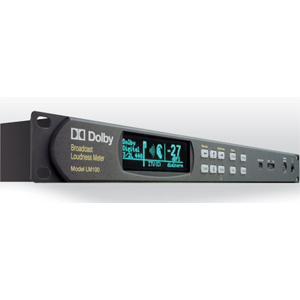 The Dolby LM100 Broadcast Loudness Meter is a tool for measuring the subjective loudness of dialogue within broadcast programming.
The Dolby LM100 Broadcast Loudness Meter is a tool for measuring the subjective loudness of dialogue within broadcast programming.
Differences in audio levels between programs, or between programs and commercials, are a major annoyance to TV viewers. However, although obvious to the viewer, these differences have proven difficult for broadcasters to measure with conventional methods and equipment. The Dolby® LM100 Broadcast Loudness Meter solves that problem through Dialogue Intelligence™, a revolutionary technology developed specifically to measure the perceived loudness of dialogue. Research shows that most viewers adjust TV volume to normalize dialogue levels. By analyzing the input signal and measuring program loudness only during the presence of speech, Dialogue Intelligence objectively measures what viewers subjectively experience.
Applications
Applications for the LM100 range from postproduction and quality control to final transmission, program turnaround, and cable head-end facilities.
Easy-to-Read Measurements
The LM100 utilizes ITU-R BS.1770-1 as its core measurement algorithm. Users can also select Leq(A). A software upgrade option is available that adds the ITU-R BS.1770-1 algorithm to existing units manufactured prior to August 2008.
The LM100 presents its measurements in an easy-to-understand numerical format. This eliminates the variations in results multiple operators often find when using VU or PPM meters, neither of which was designed to measure subjective loudness. The LM100 can also determine the unweighted peak and a range of other information about the signal. The unit can simultaneously display the incoming dialogue normalization (dialnorm) value of a Dolby Digital program (or any program within a Dolby E bitstream) for direct comparison to the actual measured value.
Front- and rear-panel serial interfaces provide capabilities for software updates and the LM100 software remote application. The remote application will assist users with advanced loudness measurement, logging features, and enhanced error reporting.
A set of user-definable alarms and monitoring functions can inform an operator of input loss, signal clipping, overmodulation (LM100-NTSC version), high or low signal levels, silence, and incorrectly set dialnorm values.
Configurations
The LM100-LTC includes a timecode input, which allows alarm and other signal conditions to be logged to either the internal time-of-day clock or external timecode. The LM100-NTSC includes an RF input specifically for NTSC CATV and “off-air” television measurement applications. Because the RF tuner replaces the linear timecode input in this version, logging is referenced to the internal clock.